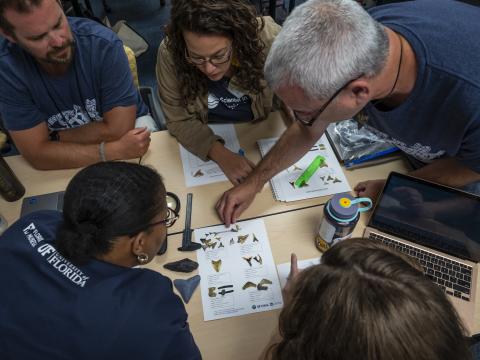Body
Image

Diving into Discovery: AI and Paleontology in Middle School
The project aims to integrate paleontology and machine learning (ML), a subfield of artificial intelligence (AI), to develop a curriculum for middle school teachers and students. Teachers attend a weeklong professional development workshop at the University of Florida to learn about AI and gain experience with the curriculum before implementing it. Over three cohorts, approximately 50 teachers will be recruited to participate in the project and to implement curricular activities in their classrooms. During implementation, STEM experts will conduct virtual or in-person classroom visits as role models. Students will learn about ML concepts, and potential future careers in AI, develop ML models to classify fossil shark teeth by form and function, and conceptualize their own ML model. The project seeks to target engagement with Title I schools in Florida to encourage underrepresented groups to increase awareness of STEM and computational technology careers. The project investigates questions on the effective integration of emerging technologies in teachers’ existing K-12 science curricula. For example, teachers’ (mis)conceptions of AI in K-12 science education, teachers’ AI self-efficacy, students’ attitudes toward science, STEM expert and teacher partnerships, and students’ conceptualization of ML models.
Pillar 1: Innovative Use of Technologies in Learning and Teaching
Our project is focused on computer vision, which leverages machine learning to classify images based on feature extraction. Project participants utilize Google’s Teachable Machine to develop models capable of classifying fossil shark teeth. In the first year, participants also developed models using another platform, Roboflow; however, we found this platform to not be ideal for our middle school audience. Using ML in this context provides an innovative way to pique student interest and curiosity in STEM subjects.
Pillar 2: Partnerships for Career and Workforce Preparation.
The project sustains valuable collaborations through STEM expert-teacher partnerships. Many of the partnerships begin to be established during the teacher PD workshop. During this time, teachers hear from experts and scholars about what AI/ML is, how they use it, and future career opportunities for students. Following the workshop, experts will visit classrooms to provide content support and serve as role models as they discuss their career path and current role.
Pillar 3: Strategies for Equity in STEM Education
The project focuses on equity in STEM education through its focus on Title I schools. Schools of greatest need are prioritized through the teacher recruitment process. Title I schools serve a high percentage of students from low-income families, many of whom belong to underrepresented groups in STEM fields. By targeting these schools, the project aims to address educational disparities and provide access to innovative STEM learning experiences for students who may have limited resources or opportunities.

Discipline(s)
Emerging Tech (Artificial Intelligence, Quantum Computing, and Blockchain)
Life sciences
Target Gradespan(s)
Middle school (6-8)
Target Participant(s)
Youth / students
Educators
Project Setting(s)
Formal Education
Category
Developing and Testing Innovations (DTI)